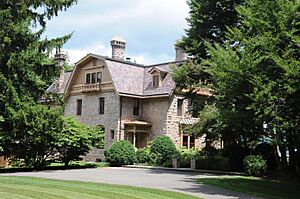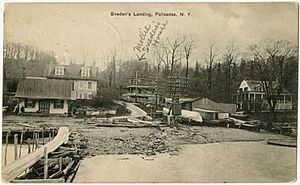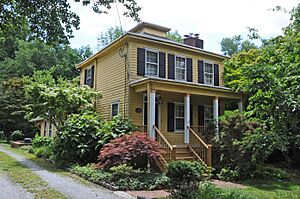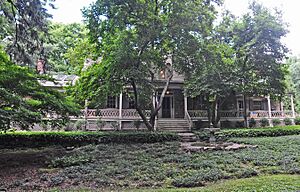Palisades, New York facts for kids
Quick facts for kids
Palisades, New York
|
|
|---|---|
| Country | United States |
| State | New York |
| County | Rockland |
| Town | Orangetown |
| Area | |
| • Land | 24.2 sq mi (63 km2) |
| • Water | 7.2 sq mi (19 km2) |
| Elevation | 194 ft (59 m) |
| Time zone | UTC−5 (Eastern (EST)) |
| • Summer (DST) | UTC−4 (EDT) |
| ZIP Code |
10964
|
| Area code(s) | 845 |
| GNIS feature ID | 959775 |
Palisades is a small community in Rockland County, New York. It's a type of small town called a hamlet. It's part of the Town of Orangetown.
This area was once known as Sneden's Landing. You might still hear that name used for the eastern part of Palisades. The hamlet also has a special area called the Closter Road–Oak Tree Road Historic District. This district is protected because of its important history.
Contents
History of Palisades
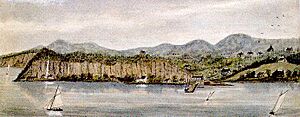
Early Days: 17th and 18th Centuries
In 1685, a man named Dr. George Lockhart bought a huge piece of land. This land, over 3,400 acres, would later become Palisades, New York. Over the next 20 years, the land was sold two more times. By 1702, there were only two houses and 14 people living there. Eight of these people were enslaved.
At this time, both New York and New Jersey claimed the land. A special group of officials settled the argument in 1769. They drew an official border between the two states. This border placed Palisades just inside New York.
Revolutionary War Times
Palisades was a very active place during the American Revolutionary War. People living here had mixed feelings about the war. Some supported the American side (called Patriots), and others supported the British (called Loyalists or Tories). This was because the area was right on the dividing line between the two fighting groups.
A famous resident was Mollie Sneden. Her family name was given to Sneden's Landing. Mollie and most of her sons were Loyalists. But her son John was a Patriot. He was allowed to keep the family ferry running across the Hudson River to Dobbs Ferry. This ferry helped people cross the river during the war.
There's a story about Mollie Sneden helping a British soldier. Patriots were chasing him down a gully. Mollie hid him in her house inside a large chest. She then put pans of cream on top of the chest. When the Patriots arrived, she told them the soldier wasn't there. They were tired and asked for a drink. She offered them milk but warned them not to touch her cream pans. Later that evening, she ferried the soldier across the river.
In November 1776, the British General Cornwallis crossed the Hudson River with 6,000 soldiers. He came from Dobbs Ferry to attack Fort Lee, New Jersey. His natural landing spot would have been Sneden's Landing. However, 500 Patriots with four cannons and a howitzer were waiting there. This forced the British to land farther south, in Closter.
In 1780, George Washington ordered a special fort, called a blockhouse, to be built at Sneden's Landing. This blockhouse guarded the ferry. It also served as a place to gather information and send messages. General Washington visited the blockhouse many times. The road leading to the ferry is even named Washington Springs Road. People say Washington and his troops drank from a small spring along this road.
This area is also linked to Benedict Arnold. He was seen in the woods here when he was trying to betray West Point. He also spent a day at the blockhouse, hiding from patrol boats on the Hudson.
After the war ended, the first official recognition of the United States happened nearby. A British warship fired a 17-gun salute. This ship had sailed to Sneden's Landing for General Sir Guy Carleton to meet General Washington.
19th Century Changes
By 1800, Palisades had 114 people. The town was perfect for river trade. The Palisades Cliff rises from the Hudson River. But at Palisades, the land is rugged but not too steep. This made it a good spot for New Jersey farmers to bring their crops. They would bring them down Washington Springs Road to the river. From there, they could ship goods across the Hudson to New York City.
New York City also needed stones for paving streets and building houses. Stones cut from the Palisades Cliff were used for many New York City streets, including Broadway. Sneden's Landing was the first easy access point to the river for about 13 miles north of where the George Washington Bridge is today. The town became so busy that a 500-foot pier was built. In the early 1800s, steamboats started using the Hudson. The Sneden family continued to ferry people and goods. They also helped connect with steamboats that couldn't dock in the shallow water near the shore.
In the mid-1800s, new railroads arrived. This meant less transportation relied on river shipping. In 1855, the town's name officially changed to Palisades.
As river trade slowed, Palisades changed. Its long pier was abandoned and fell apart. The town became more focused on farming, with orchards, vineyards, and farms. By the 1870s, wealthy New Yorkers started building summer homes in Palisades. These new residents helped the local economy. They hired local workers for their estates. They also helped the community by starting a library and a church.
20th Century Growth
At the start of the 1900s, Palisades had almost 400 people. Modern things like piped water arrived in 1910. Electricity came in 1920. Getting to Palisades by car became easier too. Route 9W was built in 1929. The George Washington Bridge opened in 1931, connecting the east and west sides of the Hudson. Finally, the Palisades Interstate Parkway opened in 1955.
Geography
Palisades is located north of Rockleigh and Alpine, New Jersey. It is east of Tappan and south of Sparkill. To the west is the Hudson River.
Arts and Culture
Historical Markers
- Skunk Hollow
- Cliffside (Palisades, New York) (listed on the National Register of Historic Places)
- Closter Road-Oak Tree Road Historic District (listed on the National Register of Historic Places)
- Washington Spring Road-Woods Road Historic District (listed on the National Register of Historic Places)
Places to Visit
- Abner Concklin House
- Big House
- Haring-Eberle House
- Little House
- Sneden's Ferry – The Sneden family ran a ferry here. John Dobbs ran one from the other side in Dobbs Ferry, New York. This ferry service started in 1698 and was one of the oldest in the area. It ran until 1944. In 1775, Martha Washington herself used this ferry. She was traveling to meet her husband, George Washington. The ferry mistress, Mollie Sneden, helped her cross the Hudson River.
- Neiderhurst
- Seven Oaks Estate
Local Organizations and Services
Palisades has a conference center run by HNA Group. It is also home to the Lamont–Doherty Earth Observatory, which is part of Columbia University. There is also a local library and a community center for residents.
Education
Students in Palisades attend schools in the South Orangetown Central School District. Older students go to Tappan Zee High School in Orangeburg.
Infrastructure
Transportation
Palisades has bus service provided by Rockland Coaches. These buses go to the George Washington Bridge Bus Terminal, the Port Authority Bus Terminal, and other places in eastern Rockland County.
Major roads and highways in the area include:
 US 9W
US 9W Palisades Parkway
Palisades Parkway NY 340
NY 340
Emergency Services
The community of Palisades is protected by the Orangetown Police Department. Medical emergencies are handled by the South Orangetown Ambulance Corps. Fire services are provided by the Sparkill-Palisades Fire Department.
Notable People
Many famous people have lived in Palisades, including:
- Trey Anastasio, musician
- Mikhail Baryshnikov, dancer, choreographer, and actor
- Chuck Barris, game show producer and host
- Lorraine Bracco, actress
- Ellen Burstyn, actress
- James Cox Chambers, billionaire businessman and heir
- Noël Coward, playwright and composer
- John Dos Passos, writer
- Tina Fey, actor
- Katharine Hepburn, actor
- William Hurt, actor
- Patricia Highsmith, writer
- Scarlett Johansson, actress
- Angelina Jolie, American actress (attended elementary school here)
- Vivien Leigh, actress
- Bill Murray, actor and comedian
- Laurence Olivier, actor
- Al Pacino, actor
- Hayden Panettiere, actress
- Jansen Panettiere, actor
- Aidan Quinn, actor
- Rodney Smith, photographer
- Edgar Snow, American journalist
- Mike Wallace, news commentator
- Orson Welles, director and actor
- Pinchas Zukerman, violinist and composer




